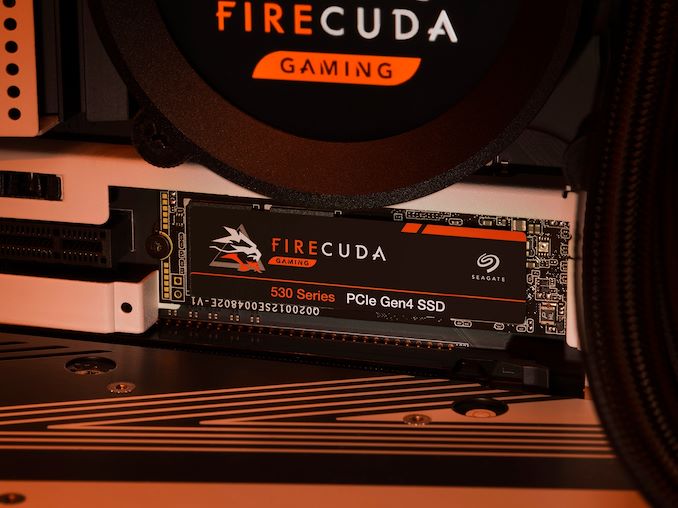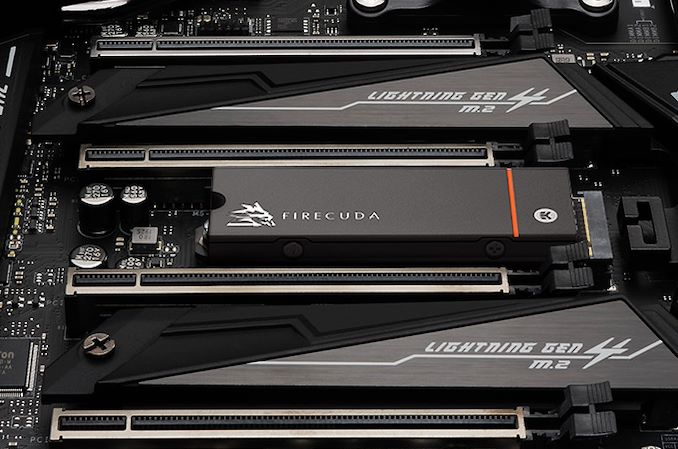Seagate Announces FireCuda 530 PCIe 4.0 SSD at SG21
by Ganesh T S on June 23, 2021 4:00 PM EST
The gaming segment continues to experience rapid growth in the PC market, and we have seen PC component vendors come up with launch events specifically targeting gamers. Seagate's inaugural Virtual Gaming Event (SG21) is the latest in this list, and the company is announcing its latest flagship SSD - the FireCuda 530 at this event. With its PCIe 4.0 x4 interface, there is a significant jump in sequential access speeds (reads up to 7300 MBps). This has has an ideal target market in the gaming segment, with the fast load times making a visible difference in the user experience.
The drives in Seagate's FireCuda SSD series have typically been based on Phison controllers using custom firmware (with the company's preferred term being 'Seagate-validated'), and the FireCuda 530 is no different. It is based on Phison's PS5018-E18 using the latest 3D TLC NAND (Micron's B47R 176L). A number of E18-based SSDs have hit the market over the 6 months, and we also reviewed the Inland Performance Plus a few weeks back. It was held back a bit by the use of 96L 3D TLC - an aspect that should be addressed by the latest 176-layer NAND.
Similar to other flagship M.2 PCIe 4.0 x4 NVMe SSDs, the FireCuda 530 also comes with a heatsink option. Unlike the ridged designs common for this application, Seagate has gone in for a minimalist option designed by EKWB - a finely-textured aluminum block weighing more than the usual finned heatsinks, while still retaining a slim profile for wide compatibility.
| Seagate FireCuda 530 SSD Specifications | ||||
| Capacity | 500 GB | 1 TB | 2 TB | 4 TB |
| Controller | Phison PS5018-E18 (PCIe 4.0 x4) | |||
| NAND Flash | 176L 3D TLC NAND (Micron B47R) | |||
| Form-Factor, Interface | Single-Sided M.2-2280, PCIe 4.0 x4, NVMe 1.4 | Double-Sided M.2-2280, PCIe 4.0 x4, NVMe 1.4 | ||
| Sequential Read | 7000 MB/s | 7300 MB/s | ||
| Sequential Write | 3000 MB/s | 6000 MB/s | 6900 MB/s | |
| Random Read IOPS | 400K | 800K | 1M | |
| Random Write IOPS | 700K | 1M | ||
| Pseudo-SLC Caching | Supported | |||
| TCG Opal Encryption | No | |||
| Warranty | 5 years (with 3 year DRS) | |||
| Write Endurance | 640 TB 0.7 DWPD |
1275 TB 0.7 DWPD |
2550 TB 0.7 DWPD |
5100 TB 0.7 DWPD |
| MSRP (non-heatsink) | $140 (25¢/GB) | $240 (25¢/GB) | $490 (21¢/GB) | $950 (21¢/GB) |
While the FireCuda 520 came with 1 DWPD ratings, Seagate has returned to conservative roots with the consumer-standard 0.7 DWPD for the write endurance of the FireCuda 530 SSDs. The heatsink is optional, since most new motherboards are providing their own M.2 cooling solution. It does add a $50 premium to the barebones version. In addition to the 5-year warranty, Seagate also includes a 3-year Rescue Data Recovery Service plan with the SSD.
Pricing is par for the course with other E18 SSDs, and the added DRS tends to pull up the value for money aspect in the high-end space. Seagate also appears to be one of the very few vendors with a 512GB option in this performance class (E18-based SSDs). This is understandable, as the amount of parallelism available in 512GB-class drives is not high enough to sustain the link bandwidth for sequential writes (The 512GB SKU tops out at 3GBps, while the 2TB and 4TB ones reach up to 6.9GBps). On the power consumption front, the average active power ranges from 5.8W for the 500GB SKU to 8.4W for the 4TB one.
Overall, the product appears to check all the right boxes for gamers and content creators looking to purchase a new PCIe 4.0 SSD this summer.
Source: Seagate











23 Comments
View All Comments
Wereweeb - Thursday, June 24, 2021 - link
PCIe 4.0 tax. And it's a GAMING SSD. It also has FIRE and a FISH in the name. Plus, it's dyed black! All those things increase price.shabby - Thursday, June 24, 2021 - link
Where's the rgb huh?!?Hxx - Thursday, June 24, 2021 - link
its not a fish bro its a fire breathing dragon....fish thing. Dragon is better than fish so +$50 right there lmaoyeeeeman - Thursday, June 24, 2021 - link
judging by their new facebook logo, they should rename Seagate to Sea Gay T.evilspoons - Thursday, June 24, 2021 - link
Perhaps you should take a deeper look into why you seem so threatened by a spectrum instead of a solid colour.yeeeeman - Saturday, June 26, 2021 - link
Perhaps I already took a look already and I know what the spectrum of color means and I don't see why any hardware company should promote things like this. Unless there are a lot of gays in the board. I am not threatened by anything...it just isn't the right place to promote a type of degenerative sexuality.Mr Perfect - Thursday, June 24, 2021 - link
"This has has an ideal target market in the gaming segment, with the fast load times making a visible difference in the user experience"Does it though? TechPowerUp usually does a few game level load tests in their SSD reviews, and the difference across all of the SSDs is usually on the orders of tens of seconds. Even between PCIe 3 and 4 drives. I don't know why, but in their tests it doesn't seem to matter.
Mr Perfect - Thursday, June 24, 2021 - link
Sorry, meant to say tenths of seconds. Fractions of seconds. The numbers after the decimal place.I should have proofed my comment better before hitting submit.
evilspoons - Thursday, June 24, 2021 - link
A lot of stuff isn't really well-optimized for high bandwidth storage, just like having a dual-core CPU didn't do a lot for a while.We're starting to see this become a thing on the new generation game consoles, like the pause-and-resume features I've seen demoed on the PS5. You can switch between multiple AAA titles that took MINUTES to load previously in a couple seconds... but it needs a better understanding of how to use the resources.
Microsoft recently updated Forza Horizon 4 to work better on the Series X and the game now loads about 75% faster on my desktop PC. It's just a matter of figuring out what we can do now.
Spunjji - Friday, June 25, 2021 - link
This is a reasonable point, but my counter to it is always the same: hardware costs tend to drop over time, so I'll invest in the hardware *after* the use case is proven, not before.As it stands, there's barely any advantage to having even a crappy NVMe drive over SATA, let alone one of the expensive high-speed drives.